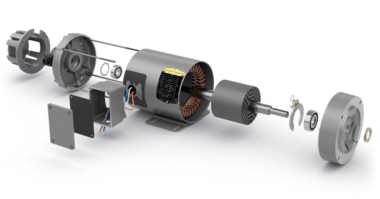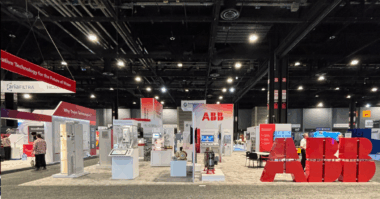In the past, sewage treatment facilities were only considered expenses, but now they generate energy for internal use during the treatment process and beyond. No network of any kind can form in the power network, to make sure all this works smoothly.
While not too many years ago, any gases forming in sewage treatment facilities were simply flared off, innovative municipal enterprises are fighting today for each kilowatt hour of energy hiding in sewage and its derivatives. Stadtwerke Trier in Germany has been demonstrating for years how to successfully boost the energy potential of digested sludge and sewage sludge by increasing its energy output. The facility not only mechanically and biologically purifies the sewage from tens of thousands of inhabitants of the region, but also supplies lots of power and heat: this energy completely powers the sewage treatment facility in annual average, but that’s not all. In the future, it will also secure the operations of an energy and technical park being developed in the vicinity – along with a spectacular, CO2-neutral data center. As far back as 2017, the Association of Municipal Enterprises (Verband Kommunaler Unternehmen) already awarded the energy self-sufficiency project with the VKU Innovation Prize. Yet the significant transformation steps on the path from energy guzzler to power generator are only now becoming imminent.
This is because up to now, the biologically active sludge was simply transferred from the tanks to digestion towers to generate sewer gas that is used to generate up to about 2.7 million kWh of power annually in two cogeneration plants and therefore builds the backbone of the energy self-sufficiency project. But as of the summer of 2021, the sewage sludge forming in the digestion tower, which earlier could only be used by farmers as fertilizer, can now be converted into energy on site by dewatering the material and burning it later as needed. This makes sense not only because the transport of sewage sludge costs a lot of money and energy, and sewage sludge can no longer be utilized on agricultural land based on a new regulation in effect as of the beginning of the year, but also because the dry sludge is easy to store as solid matter. It can then be used as an energy source if, for example, the on-site photovoltaic system that supplies about 70,000 kWh a year cannot deliver any power or the power and heat demand is especially high, be it on the site itself or in the neighboring energy park.
Getting a grip on network impurities
It’s really no surprise that special attention needs to be paid to top power network quality to ensure smooth operation of such a sophisticated system optimized for self-consumption. This is because in a situation where several consumers switch on and off with high loads in a power network, we have the threat of “network impurities” caused by the harmonics appearing during switching or controlling. This may sound harmless, but it can indeed shake up the entire network, since disruptions of individual devices can add up in the network. The result is light flickering, sensors do not operate correctly anymore, fuses fall out.
Without any countermeasures, the undesired fluctuations will impact network stability throughout the company site, which is why energy suppliers cannot tolerate such network impurities and therefore put pressure on their customers to rectify the cause. Such was the case at Stadtwerke Trier as well; following an analysis of the network, an active harmonics filter that should have eliminated the problems was acquired in 2018. However, this central filter proved to be insufficient to block disruptions within the network. ‘A number of power supplies and generators at our Sludge Pumping Station 2 broke down at the time,’ recalls Volker Lex, who is responsible for the electrical measurement, control and regulation technology in automation engineering at Stadtwerke Trier. The reason was the required pretreatment of the sludge to increase sewage gas production. Ultrasonic waves crush the sludge slowly flowing in the pipes on the way to the digestion tower, yet this “disintegration” of the sludge generated local harmonics in the power network.
Active filters were installed here as well to eliminate the problem. But following these experiences, the commercial department quickly became aware of the fact that merely treating the symptoms would be uneconomical in the long run. When focusing on the costs, it seemed more attractive to prevent the issues from appearing by implementing devices generating a low degree of network impurities. At the latest with the EMC-compliant (electromagnetic compatibility) development of the transmission station for the energy and technical park, the point was reached at which the issue of network impurities caused by drives had to be reviewed in more detail. This is because if speed and frequency are controlled by high-power motors, noticeable harmonics appear that cannot always be tolerated, and so countermeasures must be introduced.
A value that surpasses standards and guidelines
To achieve a network impurity level of less than 10 %, ABB’s ACQ580 standard water and wastewater variable speed drives series are already sufficient if a passive filter is additionally used. However according to the project call for tender the THDi value – the ‘Total Harmonic Distortion’ of electric power (i) – needed to be below 6 %. To achieve that there was no alternative but to use a ACQ580 ultra-low harmonics drive (ULH) variant. In fact, the ULH drive can reduce the degree of network impurities to less than 3 % – a negligible level. This is because this value surpasses the specifications of the IEEE519 and G5/4 guidelines, as well the IEC61000-3-12 standard.
A total of 12 pcs. of ultra-low harmonic drives were implemented in the sludge dewatering system that was commissioned in Trier in summer 2021. The system is the next step on the path to a combined drying and incineration facility, with which the Stadtwerke Trier can offer this form of sewage sludge conversion to surrounding communities as a service starting later on. The dried sludge stored in large silos in the summer can then be burnt in the winter when the demand for energy increases.
The two decanter centrifuges from manufacturer Flottweg (Vilsbiburg), which are the heart of the sewage dewatering system, are controlled by the ACQ580 ULH drives. The ULH drive indicates that we are not dealing with a standard drive here, but rather one that has an integrated network monitoring. An active IGBT (Insulated-Gate Bipolar Transistor) input bridge dampens both lower-order and higher-order harmonics in interaction with a power choke. Of the different technologies available to counter network impurities effectively, only the ABB ULH solution eliminates the need to install additional filters in the network that would impair performance. This is thanks to the integrated active bridge circuit. In practice, this guarantees power factor of 1. Since the network does not need to provide any reactive power, equipment such as cables, switchgear and transformers can be designed more lean. In addition the voltage is fully available to the ULH drive during operation so it has better efficiency, while a standard drive with a passive filter often equates up to about 5 % loss of voltage and appropriately reduced efficiency.
Yet another feature of the drive is its robust design. The integrated multiple coated circuit boards stand the test thanks to their corrosion protection directly in the sewage sector, where the vapors from the sludge can even partially penetrate through the cable ducts into the control cabinets and affect components.
What matters in practice
Volker Lex from Stadtwerke Trier first and foremost notes the uncomplicated interfaces as the reason for using the technology. The T-DL EMSR and control technology team leader praises the ease of use thanks to the clear text on the well-structured display, which offers great advantages for operating and maintenance personnel. “There is nothing worse than an abbreviation,” he notes based on daily experience. Mike Schröder, who is responsible for the entire facility as site manager with the Wolf & Sofsky corporate group (Zweibrücken), emphasizes this assessment: ‘The drives are significantly easier to operate than comparable products from other manufacturers’, the project leader notes, following the completely problem-free commissioning of the equipment in summer 2021. ‘The centrifuges start and stop without any issues at any time.’
As a matter of principle, a disruption could always occur on the drive, sewage expert Volker Lex points out. Stadtwerke Trier does not have any replacement devices in stock for such cases, but has rather set up the systems with redundancy on the one hand, and on the other hand, operators can switch over to direct start-up or soft start-up in case of a fault. ‘But although we have been using ABB drives for many years now, only one issue appeared once, and in that case the manufacturer supported us immediately,’ Lex recalls. In retrospect, he is very satisfied with the decision to opt for ABB drives. ‘Cooperation is going well, we are being well supported.’ He is also pleased with the Life Cycle assessment performed by the Service Division, where all the drives were listed and measures planned to achieve a longer service life.
Therefore, Lex has every reason to optimistically look forward to the next implementation steps in the sewage sludge drying and incineration operations, which will make use of remaining part of the energy potential hidden in the sewage. ‘The amount of energy than we can obtain from a sewage treatment facility like this is already fantastic,’ says the electrical engineering master, who still does not cease to be amazed, even after several years on the job at Stadtwerke Trier.



